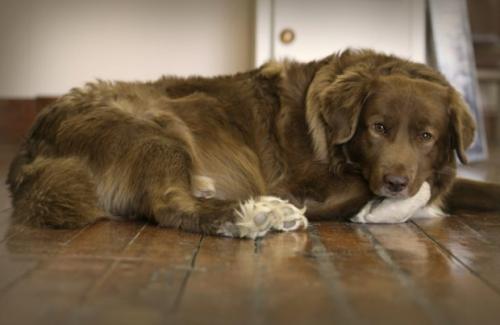Hip dysplasia is perhaps the most a common musculoskeletal system problem, found in dogs. If you plan to purchase a puppy or adult dog, then you should figure out for your own calm, is it possible for her to have dysplasia to be in aware of any potential problems.

Why dogs suffer from hip dysplasia
Contents
Joint dysplasia develops as a result of a combination genetically inherited traits and due to environmental factors Wednesday. Hip dysplasia means that this joint does not develop correctly, which leads to some degree deformation. As a rule, dysplasia begins to develop when the dog is still young, and gradually leads to a deterioration of the connection and even to a complete loss of joint functionality. Both males and females equally susceptible to dysplasia, any breed can suffer from it dogs, however, it is more common in large breeds such as Labrador, German Shepherd, Bulldog and St. Bernard. Dogs that have hip dysplasia or a predisposition to her, as you know, should not be divorced.
Hip Dysplasia in Detail
The hips of the dog are combined with the pelvis by means of a ball joint. The femoral head, called the hinge, is connected to the acetabulum a hollow that is part of the pelvis. The hinge and cavity should match perfectly to match each other and to make the ball could easily rotate, while being securely in the cavity. Two bones are held together with ligaments and connective tissue, and their connection contains a lubricating fluid that facilitates smooth movement of the hinge. Dysplasia develops when the joint does not grow normally, without the proper joint of the hinge and depressions, which also affects the muscles surrounding the joint and ligaments.
When dysplasia progresses, the surfaces of the hinge and cavity begin to lose touch with each other, and the bones begin to separate. This condition is known as subluxation. Subluxation leads to distortion the development of the joints of the hips, and is also the cause of pain and gait change. Hip Dysplasia May Affect both on one joint and both simultaneously, then this a condition called bilateral hip dysplasia the joint. Even those dogs that suffer from dysplasia are born, usually with absolutely normal joints. Therefore analysis the hip joints are not carried out in the puppy itself, but in his parents to determine his genetic predisposition to dysplasia.
Diagnosis of dysplasia
If you own or plan to purchase a dog a breed that has a higher risk of developing dysplasia, than the average for dogs, then you might consider evaluating her hips, or the hips of her parents. The assessment will be X-ray of the hips of dogs at different angles and analysis of the results. The dog that will be the least likely to develop dysplasia is the best choice in terms of its future problems. The following signs and symptoms may also testify to the development of a hip dysplasia in a dog the joint.
- Lameness of the hind legs that appears after physical exercise
- Short, intermittent step of the hind legs due to pain when joints have the largest angle of divergence
- Swinging movements of the lower back when walking or running
- Awkwardness of a dog when it scrambles or moves up down
- Bounce when the hind legs move together
- Dragging the hind legs
- Crouching Hind Leg Trekking
Hip Dysplasia
There are many surgical and medical methods. treatment of the hip joint to stop its further worsening and reduce any pain associated with it. Dysplasia the hip joint cannot be fixed with medications, and surgical methods are often not acceptable due to the financial component. Treatment also depends on many factors, including dog age, degree of development dysplasia, as well as the environment.
Painkillers and anti-inflammatory preparations
Painkillers (analgesics) and non-steroidal anti-inflammatory drugs are often prescribed for short-term the prospect of maintaining the condition of the dog so that it remains active, which in itself can improve the symptoms of the disease. These medications are just painkillers and are not medicine, as they only reduce symptoms, not provide treatment.
Diet and exercise
Dogs that maintain a healthy weight and maintain activity, suffer from less pain than those that have overweight and sedentary lifestyle. If your dog diagnosed with progressive hip dysplasia due to her physical condition, then a review of her diet and exercise needs – this is usually the first thing what you should do.
Surgical Treatment Options
There are four main surgical methods that are used in dogs suffering from dysplasia – total endoprosthetics joint, triple osteotomy, hip osteotomy and arthroplasty the joint.
- In the case of joint replacement, the injured ball hinge (in case of bilateral dysplasia on both sides) completely replaced by an artificial hinge. The depression is also replaced by artificial, i.e. the operation is similar to that performed at people. This surgery is very complex and time consuming, and performed at just a few veterinary centers.
- Triple pelvic osteotomy consists of a section of three bones in separate places so that the trough can be adjusted with hinged. Then the structure is held in place by metal plates and screws.
- In case of hip osteotomy, damaged or excess the hinge is removed and then a new joint is formed associated with using the ligaments and muscles of the thigh. Of course the dog will not recover maximum amplitude of hip movement, but this operation is like usually leads to a noticeable improvement in condition and relatively less painful.
- Arthroplasty is the introduction of an additional element in the bone, set at the edges of the hinge joint, which will protect it from displacement and stop free joint movements. This operation is relatively new, and as usually performed in young dogs.






